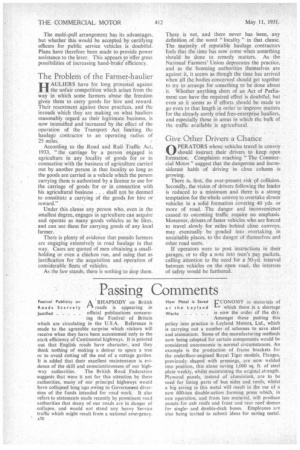Passing Comments
Page 32

Page 33

If you've noticed an error in this article please click here to report it so we can fix it.
Festival Publicity on A RHAPSODY on British Roads Scarcely r-k roads is appearing in
Justified official publications concern
ing the Festival of Britain which are circulating in the U.S.A. Reference is made to the agreeable surprise which visitors will receive when they have been accustomed only to the stark efficiency of Continental highways. It is pointed out that English roads have character, and they think nothing of making a detour to spare a tree or to avoid Cutting off the end of a cottage garden. It is added that their excellent maintenance is evidence of the skill and conscientiousness of our high way authorities. The British Road Federation suggests that were it not for this attention by these authorities, many of our principal highways would have collapsed long ago owing to Government diversion of the funds intended for road work. It also refers to statements made recently by prominent road authorities that Many of our roads are in danger of collapse, and would not stand any heavy Service traffic which might result from a national emergency. A30• How Metal is Saved VCONOMY in materials of at the Leyland I-1 which there is a shortage Works ..... is now the order of the day.
Amongst those putting this policy into practice is Leyland Motors, Ltd., which is carrying out a number of schemes to sdve steel and aluminium. Some of the manufacturing methods now being adopted for certain components would be considered uneconomic in normal circumstances. An example is the production of frame brackets for the underfloor-engined Royal Tiger models. Flanges, previously shaped with pressings, are now welded into position, this alone saving 1,000 sq. ft. of steel plate weekly, whilst maintaining the original strength. Plywood panels, instead of aluminium, are to he used for lining parts of bus sides and roofs, whilst a big saving in this metal will result in the use of a new 600-ton double-action forming press which, in one operation, and from less material, will produce panels for cab roofs and front and rear roof domes for singleand double-deck buses. Employees are also being invited to submit ideas for saving metal. Technical Points AriaA N animated discussion ing from Lecture Dtsfollowed the reading of cussion the paper, " Trends of Design," by Mr. P. M. A. Thomas, M.1.R.T.E., in London, before the Institute of Road Transport Engineers. Much of the interest concerned brake fade. It was claimed that 'makers of friction material had solved the problem, but that drum metallurgy was lagging behind. Some facings increased their coefficient of friction as the temperature rose and could give a factor of 0.46 at a temperature around 1,000 degrees F. Part of the trouble was due to drum expansion, combined with high leverage in the controls. A point regarding under-floor engines was that there might be objections to these for the carriage of inflammable liquids,
unless they were thoroughly well shielded. Rear engines might cause difficulty in changing gear unless associated with automatic transmissions, as in the States; a driver could not hear the engine or, as. it were, "feel" it. Good shock absorbers, preferably of the adjustable, hydraulic type, Were necessary. One speaker condemned vehicles with semi-forward control as having no advantages; for accessibility, the engine should be all in the cab or all out of it. Another member stated that long pipes caused inferior performance of injectors, whilst flangemounting of injection pumps facilitated and cheapened design.
Second Film on ProA S the new Esso refinery at gress of the Fawley 4ThFawley, Southampton, has Refinery been taking shape, the Esso film unit has been busy making a photographic record of its progress. One film, made last year, was widely shown throughout the country and a second, covering the period AprilDecember, 1950, was recently shown in London. As a piece of documentary film-making, it is excellent in all respects, some particularly fine photography being evident. Not only is the story of the construction conveyed in a clear non-technical manner, but there is an atmosphere of engineering achievement. The refinery will be completed in a few months and will supply the home market with over one-quarter of its requirements.




























































































